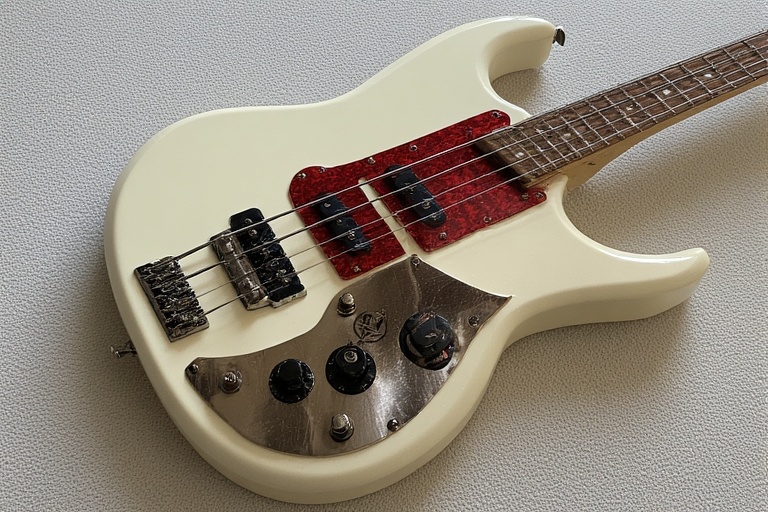
Jackson Rickenbacker Bass Cream Color
Imagine cradling a bass that whispers tales of rock legends while delivering punchy tones that cut through any mix. The Jackson Rickenbacker bass cream color captures that magic perfectly. It merges bold designs with creamy elegance, drawing eyes and ears alike. Bassists everywhere seek this gem for its unique vibe. So, dive in and discover why this instrument stands out.
The Allure of Jackson Rickenbacker Bass Cream Color
Bass players often chase instruments that blend heritage with fresh appeal. The Jackson Rickenbacker bass cream color does just that. It evokes the creamy finishes of classic Rickenbackers, yet adds Jackson’s modern edge. Therefore, musicians find it irresistible. Moreover, its light tone warms stages and studios alike. As a result, it becomes a go-to choice for pros and hobbyists. In addition, the cream hue ages gracefully, gaining character over time.
This bass shines in live settings. For instance, its sleek lines catch the light beautifully. Consequently, performers feel confident. Furthermore, the color pairs well with various rigs. So, whether you gig or jam at home, it fits seamlessly. Next, let’s explore its roots to understand its lasting charm.
History Behind the Jackson Rickenbacker Bass Cream Color
Rickenbacker basses first roared onto the scene in the 1960s. Legends like Paul McCartney popularized their distinctive jangle. Then, Jackson entered the fray, innovating with speed and aggression. The Jackson Rickenbacker bass cream color emerged from this fusion. It nods to Rickenbacker’s 4001 and 4003 models. However, Jackson infuses affordability and playability.
In the 1990s, cream finishes gained fame through signature editions. Chris Squire’s Yes-era bass inspired many. Thus, the cream color symbolized rock rebellion. Jackson, founded by Grover Jackson, drew from these icons. They crafted basses with sharkfin inlays reminiscent of triangles. As a result, the cream variant became a collector’s dream. Moreover, its history ties into broader bass evolution.
By the 2010s, Jackson released inspired models like the CBXNT DX IV. These captured Rickenbacker’s essence without the premium price. Therefore, more players accessed that signature look. In addition, the cream finish honored aged whites that yellowed beautifully. So, history meets innovation here. Now, consider how design elevates this bass.
Design Elements of the Jackson Rickenbacker Bass Cream Color
Design defines the Jackson Rickenbacker bass cream color. Its body boasts poplar wings around a maple neck-through construction. This setup ensures sustain and stability. Additionally, white binding outlines the edges crisply. Thus, the cream finish pops against it. Furthermore, the pickguard mimics Rickenbacker’s split style.
Sharkfin inlays grace the laurel fingerboard. They echo Rickenbacker’s triangles subtly. As a result, the fretboard feels familiar yet fresh. Moreover, the pointy Jackson headstock adds flair. So, it stands apart from pure replicas. In addition, skirted knobs and chrome hardware complete the retro vibe. Therefore, every detail screams quality.
The cream color itself deserves praise. It offers a soft, vintage glow. Unlike stark white, it warms under lights. Consequently, it suits diverse aesthetics. Next, delve into the features that power its performance.
Key Features That Make the Jackson Rickenbacker Bass Cream Color Stand Out
Features propel the Jackson Rickenbacker bass cream color forward. First, it sports P/J pickups for versatile tones. The P at the neck delivers thump, while the J at the bridge adds snap. Therefore, you switch effortlessly between styles. Moreover, an active 3-band EQ shapes your sound precisely.
Graphite reinforcement strengthens the maple neck. This prevents warping over years. As a result, playability remains consistent. Furthermore, 24 jumbo frets invite fast runs. So, shredders and slappers alike thrive. In addition, the compound radius fretboard—12″ to 16″—eases bends and chords.
The Bass Bacher IV bridge anchors strings firmly. It allows individual adjustments for intonation. Thus, tuning stays spot-on during gigs. Additionally, sealed die-cast tuners hold pitch reliably. Therefore, setups last longer. Now, let’s compare it to its Rickenbacker roots.
Comparing Jackson Rickenbacker Bass Cream Color to Original Rickenbackers
Comparisons reveal the Jackson Rickenbacker bass cream color’s strengths. Original Rickenbackers, like the 4003, feature horseshoe pickups for iconic clank. Jackson approximates this with covered J pickups. However, it adds modern EQ for broader range. As a result, versatility wins out.
Neck profiles differ too. Rickenbacker’s wider, shallower feel suits classics. Jackson’s speed neck accommodates shredding. Moreover, the cream finish on Jackson mimics aged Rickenbacker whites. Yet, it resists yellowing better. Therefore, maintenance eases up.
Build-wise, both use maple for resonance. But Jackson’s poplar body lightens the load. Consequently, comfort improves for long sessions. In addition, Jackson costs less—often half the price. So, accessibility shines. Furthermore, both deliver punchy lows. Thus, tone lovers find satisfaction.
| Feature | Jackson Rickenbacker Bass Cream Color | Original Rickenbacker 4003 |
|---|---|---|
| Body Material | Poplar wings with maple neck-through | Solid maple |
| Pickups | P/J active with 3-band EQ | Dual Hi-Gain single-coils |
| Fretboard | Laurel, compound radius | Rosewood, flat |
| Scale Length | 34″ | 33.25″ |
| Price Range (Approx.) | $400–$600 | $2,000+ |
| Finish Aging | Resists yellowing | Yellows to cream over time |
| Weight (Avg.) | 8–9 lbs | 9–10 lbs |
This table highlights key differences. Clearly, Jackson offers value without sacrificing soul.
Sound Profile: Why the Jackson Rickenbacker Bass Cream Color Delivers Iconic Tones
Sound defines any bass, and the Jackson Rickenbacker bass cream color excels. Boost the mids, and you get that Rickenbacker jangle. However, dial in lows for Fender-like growl. Therefore, it spans genres seamlessly. Moreover, the active preamp adds clarity without mud.
In reviews, players praise its punch. For example, it cuts through rock mixes effortlessly. As a result, live volumes stay balanced. Furthermore, the neck-through design sustains notes richly. So, every pluck rings true. In addition, blend controls mix pickups creatively. Thus, tones evolve with your style.
Compared to passive Rickenbackers, Jackson’s electronics shine brighter. They handle high gain without feedback. Consequently, metal riffs roar. Yet, for jazz, roll back treble gently. Therefore, adaptability rules. Now, explore maintenance for longevity.
Maintenance Tips for Your Jackson Rickenbacker Bass Cream Color
Maintenance keeps the Jackson Rickenbacker bass cream color pristine. First, wipe the cream finish with a microfiber cloth after plays. This removes sweat and grime. Moreover, use polish sparingly to preserve the gloss. As a result, the hue stays vibrant.
For the fretboard, condition laurel monthly with lemon oil. Thus, it prevents drying cracks. Furthermore, check truss rod seasonally. So, action remains low and buzz-free. In addition, store in a gig bag away from sunlight. Therefore, cream avoids fading.
Electronics need care too. Clean pots with contact spray yearly. Consequently, knobs turn smoothly. Also, restring with nickel-plated sets for tone match. Hence, the bass performs optimally. With these steps, it lasts decades.
Famous Musicians and the Influence of Cream-Colored Basses
Musicians elevate the Jackson Rickenbacker bass cream color’s legacy. Chris Squire of Yes wielded a cream 4001CS iconically. His lines in “Roundabout” inspired generations. Therefore, cream became synonymous with prog rock. Moreover, Paul McCartney’s Rickenbacker, though Fireglo, influenced finishes broadly.
Modern players adopt Jackson’s version. For instance, session pros use it for its affordability. As a result, cream basses appear in indie tours. Furthermore, Lemmy Kilmister’s modified Rickenbacker nods to bold colors. So, the cream variant fits rebellious spirits. In addition, Geddy Lee’s high-energy style suits its punch.
These icons prove cream’s versatility. Thus, grab one to join the lineage.
Customization Options for the Jackson Rickenbacker Bass Cream Color
Customization enhances the Jackson Rickenbacker bass cream color. Start with pickup swaps for warmer tones. Nordstrand options add woolly depth. Moreover, refinish edges for personal flair. As a result, uniqueness grows.
Engrave the headstock subtly. Therefore, it tells your story. Furthermore, upgrade tuners to locking models. So, stability improves. In addition, add LED side markers for dim stages. Hence, playability boosts.
Pro luthiers offer binding tweaks too. Thus, match vintage Rickenbackers closer. With these mods, your bass evolves. Now, hear from users.
User Reviews: What Bassists Say About Jackson Rickenbacker Bass Cream Color
Reviews rave about the Jackson Rickenbacker bass cream color. One player notes, “It clanks like a Rick but plays faster.” Therefore, versatility wins praise. Moreover, another says, “The cream finish glows on stage—stunning!” As a result, aesthetics score high.
Gigging bassists love its weight. “Light yet resonant,” claims a touring pro. Furthermore, the EQ draws compliments. “Shapes tones instantly,” adds a studio engineer. So, professionals endorse it. In addition, beginners appreciate the setup. “Fret ends are perfect—no snags,” shares a newbie.
Critics mention the headstock’s boldness. However, most overlook it for sound. Thus, overall satisfaction soars.
Where to Buy the Jackson Rickenbacker Bass Cream Color
Buying the Jackson Rickenbacker bass cream color is straightforward. Major retailers stock it online. Check for bundles with cases. Moreover, local shops offer try-before-buy. As a result, decisions ease.
Watch for sales—prices dip often. Therefore, snag deals wisely. Furthermore, verify authenticity via serial numbers. So, fakes stay away. In addition, read return policies. Hence, fit guarantees peace.
International buyers note shipping fees. Thus, compare costs. Ready to own one?
FAQs
What makes the Jackson Rickenbacker bass cream color unique?
The Jackson Rickenbacker bass cream color blends Rickenbacker’s retro aesthetics with Jackson’s speed-focused build. It features P/J pickups, active EQ, and a creamy finish that ages beautifully. Therefore, it offers iconic looks at an accessible price.
Is the cream finish on Jackson Rickenbacker bass durable?
Yes, the cream finish resists yellowing better than vintage whites. However, avoid direct sun to maintain vibrancy. Moreover, regular wiping keeps it glossy. As a result, it holds up well for daily use.
Can beginners play the Jackson Rickenbacker bass cream color?
Absolutely. Its compound fretboard and low action suit novices. Furthermore, the versatile tones build confidence. So, start simple and grow. In addition, tutorials abound online.
How does the sound of Jackson Rickenbacker bass cream color compare to a real Rickenbacker?
It captures the jangle and punch closely via EQ tweaks. Yet, Jackson adds modern clarity. Therefore, it’s ideal for rock and beyond. Moreover, sustain rivals originals.
What genres suit the Jackson Rickenbacker bass cream color best?
Rock, prog, and metal thrive on its growl. However, jazz and funk work too with blend adjustments. As a result, versatility spans styles. Furthermore, live mixes favor its cut.
Conclusion: Elevate Your Sound with the Jackson Rickenbacker Bass Cream Color Today
The Jackson Rickenbacker bass cream color stands as a beacon for bass enthusiasts. It fuses history, design, and tone into one creamy package. From its resonant build to versatile sounds, it delivers endlessly. Moreover, reviews confirm its reliability. So, why wait? Grab your Jackson Rickenbacker bass cream color now and unleash legendary riffs. Your next gig awaits—make it unforgettable.



